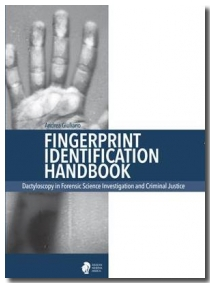Non ci sono recensioni
This Handbook refers to Dactyloscopy (also called Fingerprint Study or Friction Ridge Study). For more than a century, fingerprints have been useful in a wide range of applications, because they can be used for identification due to fundamental principles: immutability in the course of life (they are permanent) and uniqueness because always different (they are individual). In forensics, there are very large databases that allow the recognition of aliases, traces found at a crime scene and unknown bodies.
This Handbook is organized into 4 Sections: 1) Toolbox, 2) Known Prints, 3) Latent Prints, 4) Other Fields. The first concerns basic knowledge of the field, i.e., history, anatomy, embryology and the morphology of the friction ridges of the finger, hand and foot. The second concerns personal identification, including print-taking techniques and search procedures. The third concerns latent prints, including the analysis and comparison of traces found at a crime scene. Finally, the fourth concerns different fields such as deceased and missing persons, at¬tempts to counterfeit fingerprints, biometric recognition, cross-border service applica¬tions and the use of fingerprints in archaeology and anthropology. It is divided into 25 Chapters
SECTION1
HISTORY
Introduction
Prehistoric Hands
Ancient Marks
Forerunners
From Anthropometry to Dactyloscopy
Italian Way
Development of Dactyloscopy
References
HAND AND SKIN
Introduction
Hand
Short Anatomical Description
Touch, Prehension and Movement
Abnormalities
Skin
Hypodermis
Dermis
Dermal-Epidermal Layer
Epidermis
Glands
Eccrine Glands
Apocrine Glands
Sebaceous Glands
Variation and Admixture of Residues
Skin and its States
Normal, Dry or Oily Skin
Senile Skin
Friction Skin
Ridges and Furrows
Incipient Ridges
Pores
Anatomical Examination vs. Dactyloscopic Examination
References
EMBRYOGENESIS OF FRICTION RIDGES
Introduction
Development of Friction Ridges
Configuration of the Friction Ridge Patterns
References
FINGERPRINTS
Introduction
General Characteristics (Level 1)
Ridge Flows
Incipient Ridges
Core Area
Delta Area
Pattern Types
Main Classifications
Arches
Loops
Whorls
Compounds
Particular Characteristics (Level 2)
Minutiae
Main Types
Evaluation Difficulties
Microscopic Characteristics (Level 3)
Poroscopy
Overview
Taking and Comparison
Edgeoscopy
References
LOWER PHALANGE PRINTS (LOWER JOINTS)
Introduction
Morphological Description
Medial Phalange
Proximal Phalange
Identification Value
References
PALMPRINTS
Introduction
Presumptive Negative Aspects
Overview
Morphological Description
Interdigital Area
Hypothenar Area
Thenar Area
References
SOLEPRINTS
Introduction
Short Anatomical Description
Soleprints and Footprints
Overview
Morphological Description
Identification Value
References
FRICTION RIDGE DISORDERS (POOR QUALITY PRINTS)
Introduction
Permanent or Temporary Effects
Causes
Creases of the Skin (White Lines)
Aging
Injuries (Scars)
Occupational Marks
High Level of Exposure or Contact with Harmful Substances
Medical Disorders
Alterations of Sweat Production
Effects of Medicines and Therapies
References
SECTION2
RECORDING CRIMINAL METHODS
Introduction
Identity and Identification
False Statements (Aliases)
Recording Systems and their Evolution
Photographic Method
Descriptive Method
Anthropometric Method
Dactyloscopic Method
References
TAKING KNOWN PRINTS
Introduction
Taking by Ink
Rolled and Plain Prints
Taking Lower Phalange Prints
Taking Palmprints
Taking Major Case Prints
Problems
Taking by Live Scan
Sensors
Live Scan Requirements
Problems
Related to the Skin Conditions
Related to the Contact with the Sensor Surface
Related to the Devices
Control Programs
Other Techniques
Some Older Techniques
Photographic Method
Dusting-Tape Method
Special Chemically-Treated Paper Method
Replica Method
Summary Chart
References
RECOGNITION BY MANUAL CLASSIFICATIONS
Introduction
Ten-Print Classifications
Uses and Tools
Problems
Five-Print Classifications
Single-Finger Classifications
Palmprint Classifications
Others
References
RECOGNITION BY AFIS
Introduction
Historical Note
Databases
Main Processes
Acquisition
Analysis
Search (Ten-Print Database)
Verification (Ten-Print Database)
Search (Unsolved Latent Database)
Verification (Unsolved Latent Database)
Summary
Pre-Post AFIS
Problems
Direct
Indirect
Incidental
References
SECTION3
CRIME SCENE INVESTIGATION AND COLLECTION OF EVIDENCE
Introduction
Crime Scene Inspection
Fundamental Principles
Traces
Documentation
References
LATENT PRINT STATES
Introduction
Evidence Prints
Faintly Visible Prints
Visible Prints by Addition
Visible Prints by Removal
Visible Prints by Impression
Latent Prints
Transferred Prints
Electronic Capture Prints
Evidence Prints (Differently Papillary)
Other Skin Impressions
Gloved Handprints
Animal Tracks
Fabric Textures
References
LATENT PRINT DEVELOPMENT
Introduction
Development (in general)
Optical Techniques
Physical-Chemical Techniques
Development (in specific)
Print Development on Live or Dead Human Skin
Print Development on Nails
Print Development Techniques and DNA Profiling Techniques
Age Estimation of Papillary Traces
References
LATENT PRINT REVERSED
Introduction
Reversal
Gray Level Method
Genuine Dimension
Tonally Reversed
Laterally Reversed
Latent Print States and Reversal
Faintly Visible Prints
Visible Prints by Addition
Visible Prints by Removal
Visible Prints by Impression
Latent Prints
Transferred Prints
Electronic Capture Prints
Reversal in relation to Lifting Techniques
Acetate Adhesive with a Black Cover
Acetate Adhesive with a White Cover
Acetate Adhesive with a Transparent Cover
Black Rubber Adhesive
White Rubber Adhesive
Transparent Rubber Adhesive
Silicone Rubber Compounds
References
ANALYSIS
Introduction
Approaches
Requirements
Analysis Procedures
Technique
Instruments
Description
Problems
Related to the Quality and Quantity of the Traces
Related to the Accuracy of Reproduction
References
COMPARISON
Introduction
Comparison Types
Comparison Against Elimination Prints
Comparison Against Known Prints of Suspects
Comparison Against Known Prints in Databases
Comparison Procedures
Requirements Check
General Examination
Particular Examination
Instruments
Problems
Related to the Quality and Quantity of the Traces
Related to the Natural Elasticity of the Skin
Related to Cases of Only Apparent Similarity
References
LATENT PRINT RECOGNITION BY AFIS AND APIS
Introduction
Databases
Main Processes
Acquisition
Analysis
Search (Ten-Print or Palmprint Database)
Verification (Ten-Print or Palmprint Database)
Search (Unsolved Latent Database)
Verification (Unsolved Latent Database)
Summary
Pre-Post AFIS and APIS
Problems
Direct
Indirect
Incidental
Why are some Identifications Missed?
References
EVALUATION AND VERIFICATION
Introduction
Evaluation
Exclusion
Individualization
Inconclusive
Verification
Court Exhibit
Approaches
Empirical Standard Approach vs. Holistic Approach
Proof of Presence Value vs. Proof of Guilt Value
Guarding Against Error
Human Factor
New Technologies Factor
Procedural Factor
Concluding Remarks and Possible Safeguards
References
SECTION 4
IDENTIFYING THE DECEASED AND MISSING PERSONS
Introduction
Historical Background
Stages of Death
Rigor Mortis
Putrefaction
Maceration
Mummification
Saponification
Burned
Injuries
Taking Impressions
Precautionary Warnings
Techniques
Direct Methods (without contact)
Indirect Methods (by contact)
Indirect Methods (by making a replica)
Treatment Methods (by restorative solutions)
Removal Methods (by adapting the skin)
Electronic Methods (by optical scan)
Search Procedures
Official Channel
Alternative Channel
Main Processes
Some Routine Cases
Mass Disasters
Processes and DVI Form
Cooperative Approach and DVI Team
Missing Persons
References
ATTEMPTS TO COUNTERFEIT FINGERPRINTS
Introduction
Attempts to Prevent Recognition
Expedients Used to Alter the Friction Ridges
By Sharp or Pointed Tools
By Abrasions
By Burns
By Caustic Substances
By Maceration
By Stratification
By Plastic Surgery
Overview
Illegible Fingerprints
Workable Solutions
Attempts by Fake Prints
False Registration
False Authentication
False Presence
Overview
Workable Solutions
Attempts by Forged Prints
Adulteration
Tampering
Manipulation
Overview
Workable Solutions
Attempts to Not Place Prints
References
BIOMETRIC RECOGNITION
Introduction
Historical Background
Biometrics and Recognition
Main Biometric Parameters
Biometric Fingerprint Recognition
Processes
Enrollment Step (Capturing, Extraction and Storage)
Recognition Step (Matching)
Errors
Enrollment Step Errors
Recognition Step Errors
Applications
Public
Private
Commercial
Immigration and Cross-Border Service Applications
Border Protection
Passport
Visa Information System
Residence Permit
Eurodac
Schengen Information System
Cross-Border Cooperation, Data Exchange (Prüm Decision) and Accreditation (EN ISO/IEC 17025)
Civilian Fingerprinting Extension
References
DACTYLOSCOPY AND ARCHAEOLOGY
Introduction
Fields
Prehistoric Depictions
Impressions of Ancient Artifacts
Painting Impressions
Purposes
Overview
Controversies
References
DACTYLOSCOPY AND ANTHROPOLOGY
Introduction
Fields
Pattern Evolution
Character Frequency
Symmetry Relationships
Variation due to Gender or Age
Inheritability in Populations
Inheritability in Households
General Similarities in Identical Twins
Other Fields
Mummy Prints
Primate Prints
Prints in Nature
Purposes
Overview
Controversies
References




